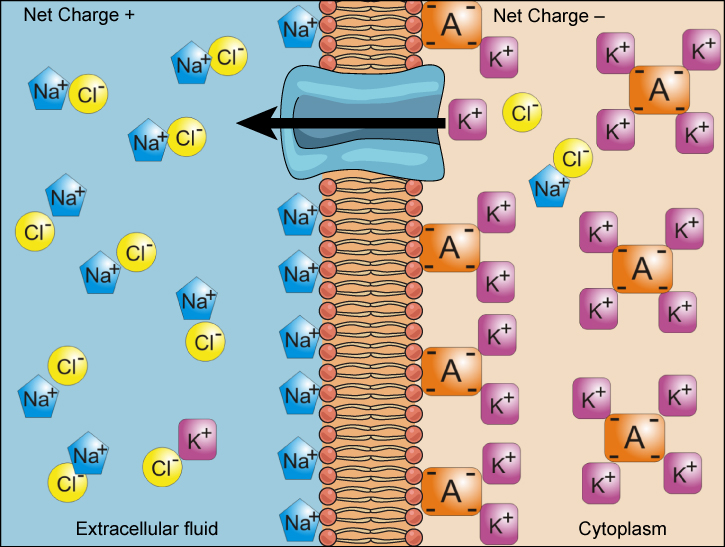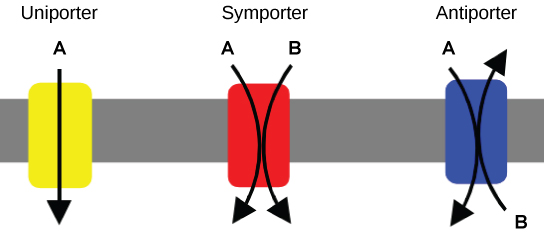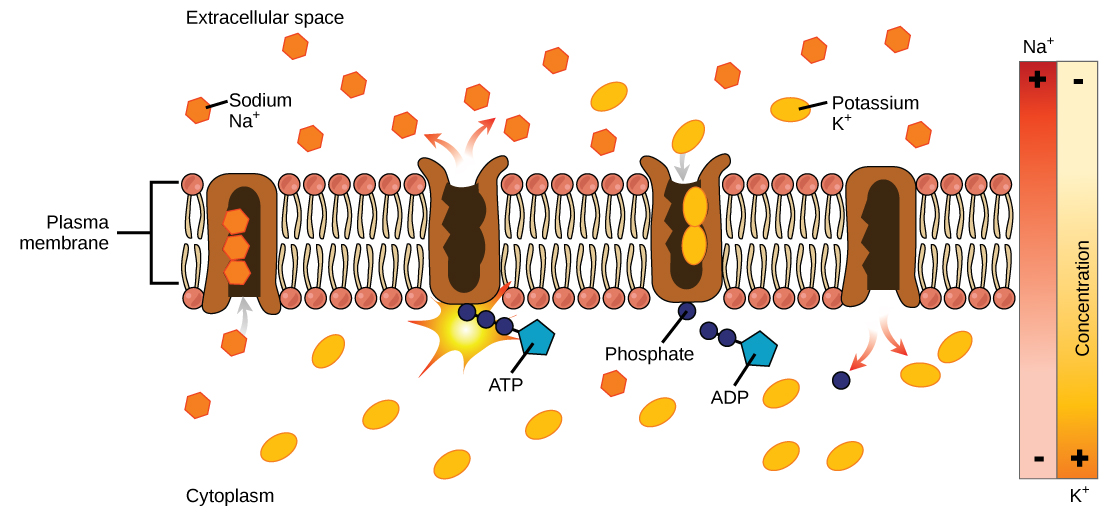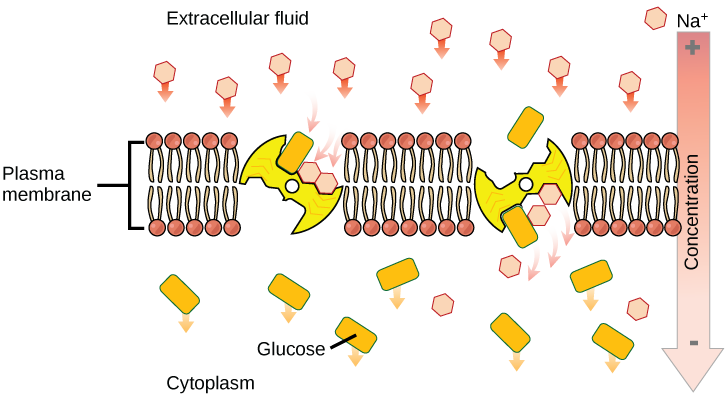Active Transport
Overview
- Understand how electrochemical gradients affect ions
- Distinguish between primary active transport and secondary active transport
Active transport mechanisms require the cell’s energy, usually in the form of adenosine triphosphate (ATP). If a substance must move into the cell against its concentration gradient—that is, if the substance's concentration inside the cell is greater than its concentration in the extracellular fluid (and vice versa)—the cell must use energy to move the substance. Some active transport mechanisms move small-molecular weight materials, such as ions, through the membrane. Other mechanisms transport much larger molecules.
Electrochemical Gradient
We have discussed simple concentration gradients—a substance's differential concentrations across a space or a membrane—but in living systems, gradients are more complex. Because ions move into and out of cells and because cells contain proteins that do not move across the membrane and are mostly negatively charged, there is also an electrical gradient, a difference of charge, across the plasma membrane. The interior of living cells is electrically negative with respect to the extracellular fluid in which they are bathed, and at the same time, cells have higher concentrations of potassium (K+) and lower concentrations of sodium (Na+) than the extracellular fluid. Thus in a living cell, the concentration gradient of Na+ tends to drive it into the cell, and its electrical gradient (a positive ion) also drives it inward to the negatively charged interior. However, the situation is more complex for other elements such as potassium. The electrical gradient of K+, a positive ion, also drives it into the cell, but the concentration gradient of K+ drives K+ out of the cell (Figure). We call the combined concentration gradient and electrical charge that affects an ion its electrochemical gradient.
Art Connection

Injecting a potassium solution into a person’s blood is lethal. This is how capital punishment and euthanasia subjects die. Why do you think a potassium solution injection is lethal?
Moving Against a Gradient
To move substances against a concentration or electrochemical gradient, the cell must use energy. This energy comes from ATP generated through the cell’s metabolism. Active transport mechanisms, or pumps, work against electrochemical gradients. Small substances constantly pass through plasma membranes. Active transport maintains concentrations of ions and other substances that living cells require in the face of these passive movements. A cell may spend much of its metabolic energy supply maintaining these processes. (A red blood cell uses most of its metabolic energy to maintain the imbalance between exterior and interior sodium and potassium levels that the cell requires.) Because active transport mechanisms depend on a cell’s metabolism for energy, they are sensitive to many metabolic poisons that interfere with the ATP supply.
Two mechanisms exist for transporting small-molecular weight material and small molecules. Primary active transport moves ions across a membrane and creates a difference in charge across that membrane, which is directly dependent on ATP. Secondary active transport does not directly require ATP: instead, it is the movement of material due to the electrochemical gradient established by primary active transport.
Carrier Proteins for Active Transport
An important membrane adaption for active transport is the presence of specific carrier proteins or pumps to facilitate movement: there are three protein types or transporters (Figure). A uniporter carries one specific ion or molecule. A symporter carries two different ions or molecules, both in the same direction. An antiporter also carries two different ions or molecules, but in different directions. All of these transporters can also transport small, uncharged organic molecules like glucose. These three types of carrier proteins are also in facilitated diffusion, but they do not require ATP to work in that process. Some examples of pumps for active transport are Na+-K+ ATPase, which carries sodium and potassium ions, and H+-K+ ATPase, which carries hydrogen and potassium ions. Both of these are antiporter carrier proteins. Two other carrier proteins are Ca2+ ATPase and H+ ATPase, which carry only calcium and only hydrogen ions, respectively. Both are pumps.

Primary Active Transport
The primary active transport that functions with the active transport of sodium and potassium allows secondary active transport to occur. The second transport method is still active because it depends on using energy as does primary transport (Figure).

One of the most important pumps in animal cells is the sodium-potassium pump (Na+-K+ ATPase), which maintains the electrochemical gradient (and the correct concentrations of Na+ and K+) in living cells. The sodium-potassium pump moves K+ into the cell while moving Na+ out at the same time, at a ratio of three Na+ for every two K+ ions moved in. The Na+-K+ ATPase exists in two forms, depending on its orientation to the cell's interior or exterior and its affinity for either sodium or potassium ions. The process consists of the following six steps.
- With the enzyme oriented towards the cell's interior, the carrier has a high affinity for sodium ions. Three ions bind to the protein.
- The protein carrier hydrolyzes ATP and a low-energy phosphate group attaches to it.
- As a result, the carrier changes shape and reorients itself towards the membrane's exterior. The protein’s affinity for sodium decreases and the three sodium ions leave the carrier.
- The shape change increases the carrier’s affinity for potassium ions, and two such ions attach to the protein. Subsequently, the low-energy phosphate group detaches from the carrier.
- With the phosphate group removed and potassium ions attached, the carrier protein repositions itself towards the cell's interior.
- The carrier protein, in its new configuration, has a decreased affinity for potassium, and the two ions moves into the cytoplasm. The protein now has a higher affinity for sodium ions, and the process starts again.
Several things have happened as a result of this process. At this point, there are more sodium ions outside the cell than inside and more potassium ions inside than out. For every three sodium ions that move out, two potassium ions move in. This results in the interior being slightly more negative relative to the exterior. This difference in charge is important in creating the conditions necessary for the secondary process. The sodium-potassium pump is, therefore, an electrogenic pump (a pump that creates a charge imbalance), creating an electrical imbalance across the membrane and contributing to the membrane potential.
Link to Learning
Watch this video to see an active transport simulation in a sodium-potassium ATPase.
Secondary Active Transport (Co-transport)
Secondary active transport brings sodium ions, and possibly other compounds, into the cell. As sodium ion concentrations build outside of the plasma membrane because of the primary active transport process, this creates an electrochemical gradient. If a channel protein exists and is open, the sodium ions will pull through the membrane. This movement transports other substances that can attach themselves to the transport protein through the membrane (Figure). Many amino acids, as well as glucose, enter a cell this way. This secondary process also stores high-energy hydrogen ions in the mitochondria of plant and animal cells in order to produce ATP. The potential energy that accumulates in the stored hydrogen ions translates into kinetic energy as the ions surge through the channel protein ATP synthase, and that energy then converts ADP into ATP.
Art Connection

If the pH outside the cell decreases, would you expect the amount of amino acids transported into the cell to increase or decrease?
Section Summary
The combined gradient that affects an ion includes its concentration gradient and its electrical gradient. A positive ion, for example, might diffuse into a new area, down its concentration gradient, but if it is diffusing into an area of net positive charge, its electrical gradient hampers its diffusion. When dealing with ions in aqueous solutions, one must consider electrochemical and concentration gradient combinations, rather than just the concentration gradient alone. Living cells need certain substances that exist inside the cell in concentrations greater than they exist in the extracellular space. Moving substances up their electrochemical gradients requires energy from the cell. Active transport uses energy stored in ATP to fuel this transport. Active transport of small molecular-sized materials uses integral proteins in the cell membrane to move the materials. These proteins are analogous to pumps. Some pumps, which carry out primary active transport, couple directly with ATP to drive their action. In co-transport (or secondary active transport), energy from primary transport can move another substance into the cell and up its concentration gradient.
Art Connections
Figure Injecting a potassium solution into a person’s blood is lethal. Capital punishment and euthanasia utilize this method in their subjects. Why do you think a potassium solution injection is lethal?
Hint:
Figure Cells typically have a high concentration of potassium in the cytoplasm and are bathed in a high concentration of sodium. Injection of potassium dissipates this electrochemical gradient. In heart muscle, the sodium/potassium potential is responsible for transmitting the signal that causes the muscle to contract. When this potential is dissipated, the signal can’t be transmitted, and the heart stops beating. Potassium injections are also used to stop the heart from beating during surgery.
Figure If the pH outside the cell decreases, would you expect the amount of amino acids transported into the cell to increase or decrease?
Hint:
Figure A decrease in pH means an increase in positively charged H+ ions, and an increase in the electrical gradient across the membrane. The transport of amino acids into the cell will increase.
Review Questions
Active transport must function continuously because __________.
- plasma membranes wear out
- not all membranes are amphiphilic
- facilitated transport opposes active transport
- diffusion is constantly moving solutes in opposite directions
Hint:
D
How does the sodium-potassium pump make the interior of the cell negatively charged?
- by expelling anions
- by pulling in anions
- by expelling more cations than are taken in
- by taking in and expelling an equal number of cations
Hint:
C
What is the combination of an electrical gradient and a concentration gradient called?
- potential gradient
- electrical potential
- concentration potential
- electrochemical gradient
Hint:
D
Free Response
Where does the cell get energy for active transport processes?
Hint:
The cell harvests energy from ATP produced by its own metabolism to power active transport processes, such as the activity of pumps.
How does the sodium-potassium pump contribute to the net negative charge of the interior of the cell?
Hint:
The sodium-potassium pump forces out three (positive) Na+ ions for every two (positive) K+ ions it pumps in, thus the cell loses a positive charge at every cycle of the pump.
Glucose from digested food enters intestinal epithelial cells by active transport. Why would intestinal cells use active transport when most body cells use facilitated diffusion?
Hint:
Intestinal epithelial cells use active transport to fulfill their specific role as the cells that transfer glucose from the digested food to the bloodstream. Intestinal cells are exposed to an environment with fluctuating glucose levels. Immediately after eating, glucose in the gut lumen will be high, and could accumulate in intestinal cells by diffusion. However, when the gut lumen is empty, glucose levels are higher in the intestinal cells. If glucose moved by facilitated diffusion, this would cause glucose to flow back out of the intestinal cells and into the gut. Active transport proteins ensure that glucose moves into the intestinal cells, and cannot move back into the gut. It also ensures that glucose transport continues to occur even if high levels of glucose are already present in the intestinal cells. This maximizes the amount of energy the body can harvest from food.
The sodium/calcium exchanger (NCX) transports sodium into and calcium out of cardiac muscle cells. Describe why this transporter is classified as secondary active transport.
Hint:
The NCX moves sodium down its electrochemical gradient into the cell. Since sodium’s electrochemical gradient is created by the Na+/K+ pump, a transport pump that requires ATP hydrolysis to establish the gradient, the NCX is a secondary active transport process.